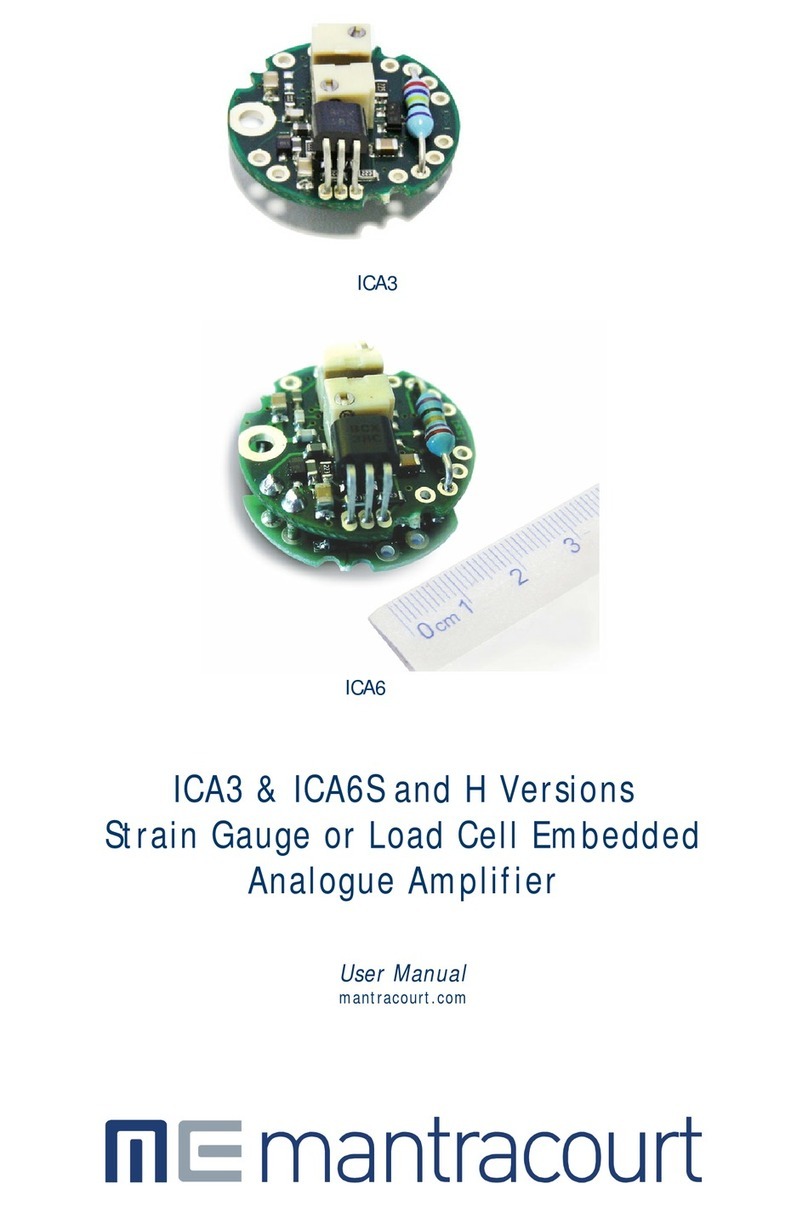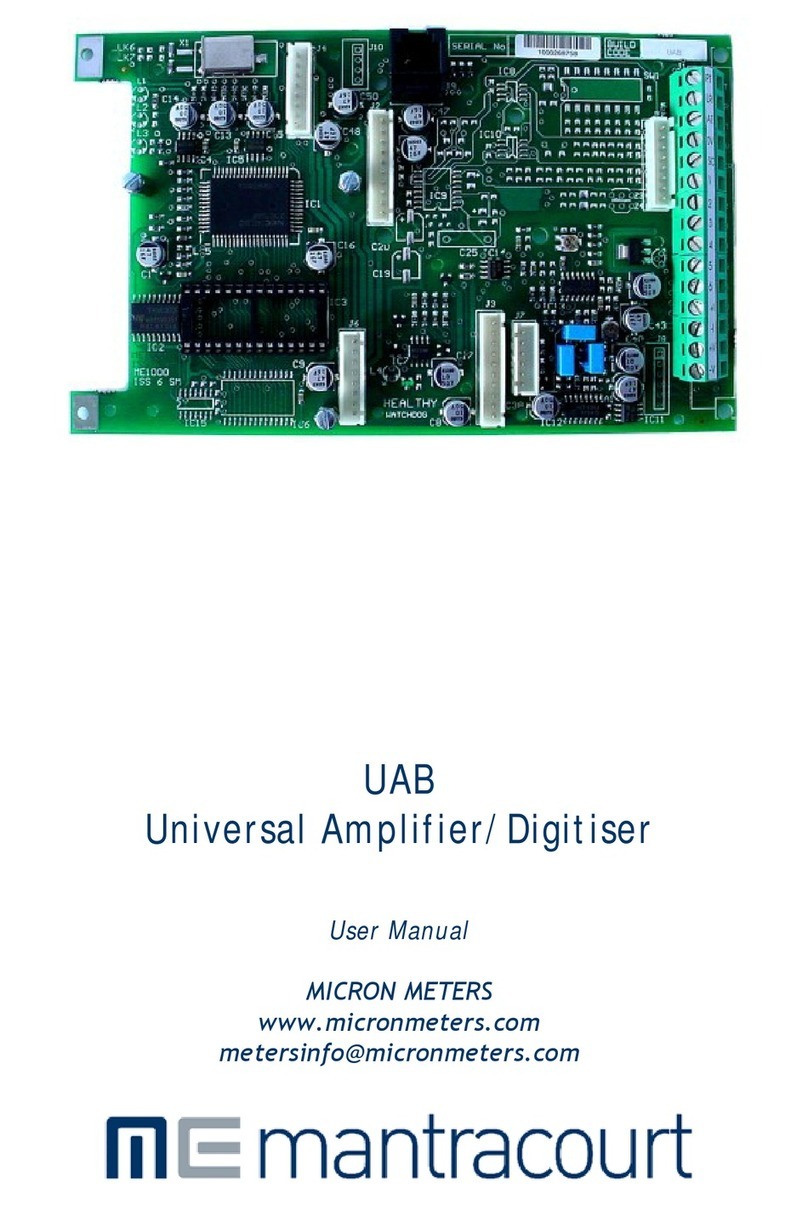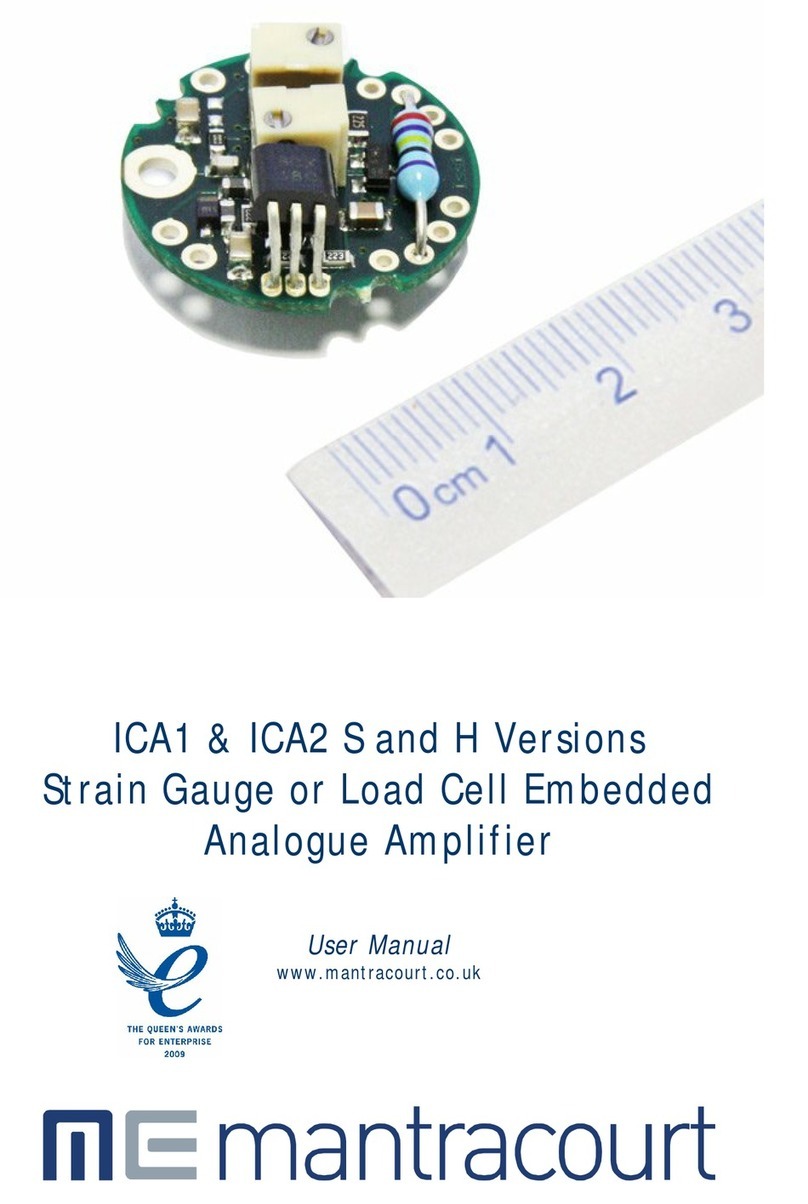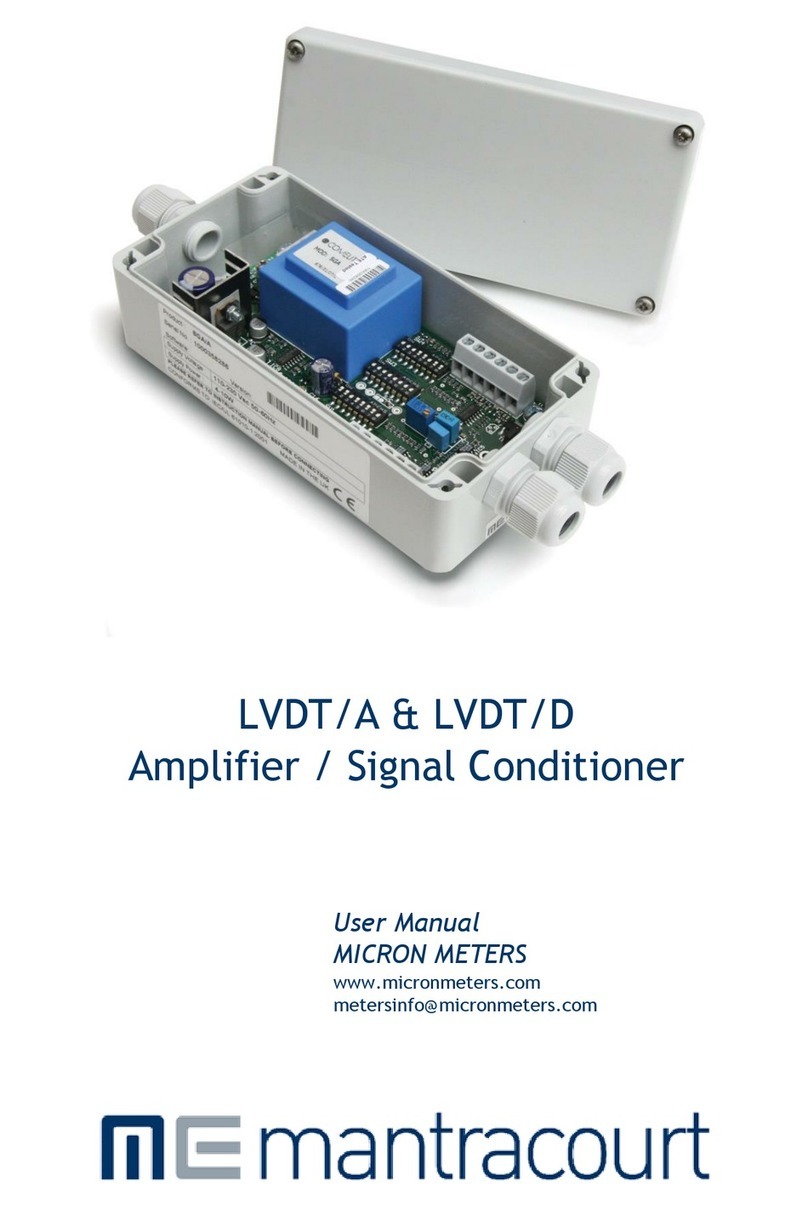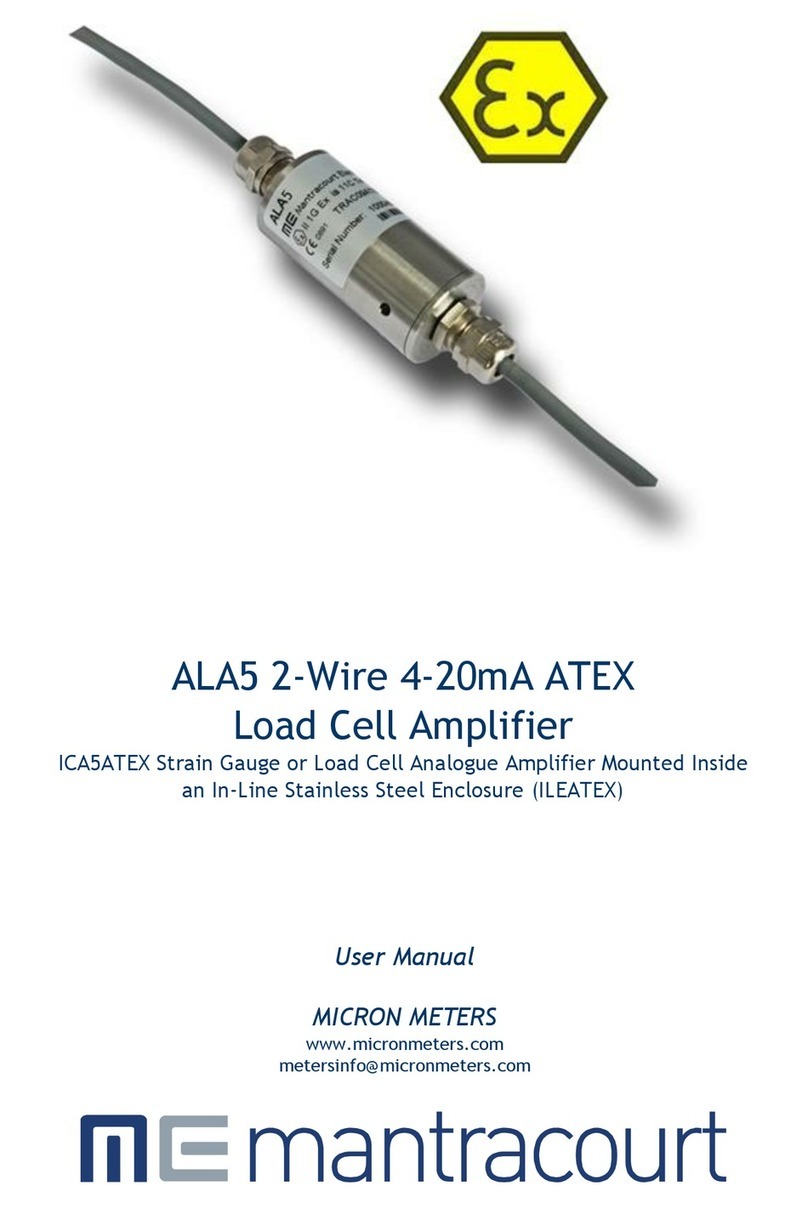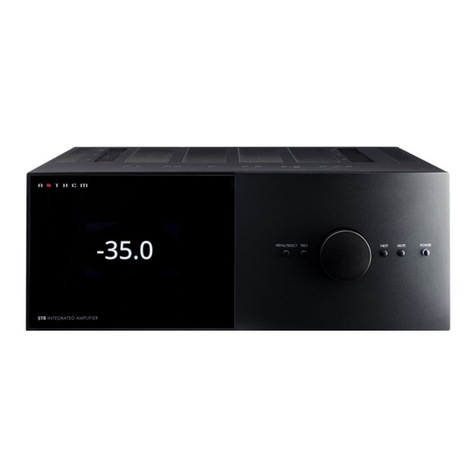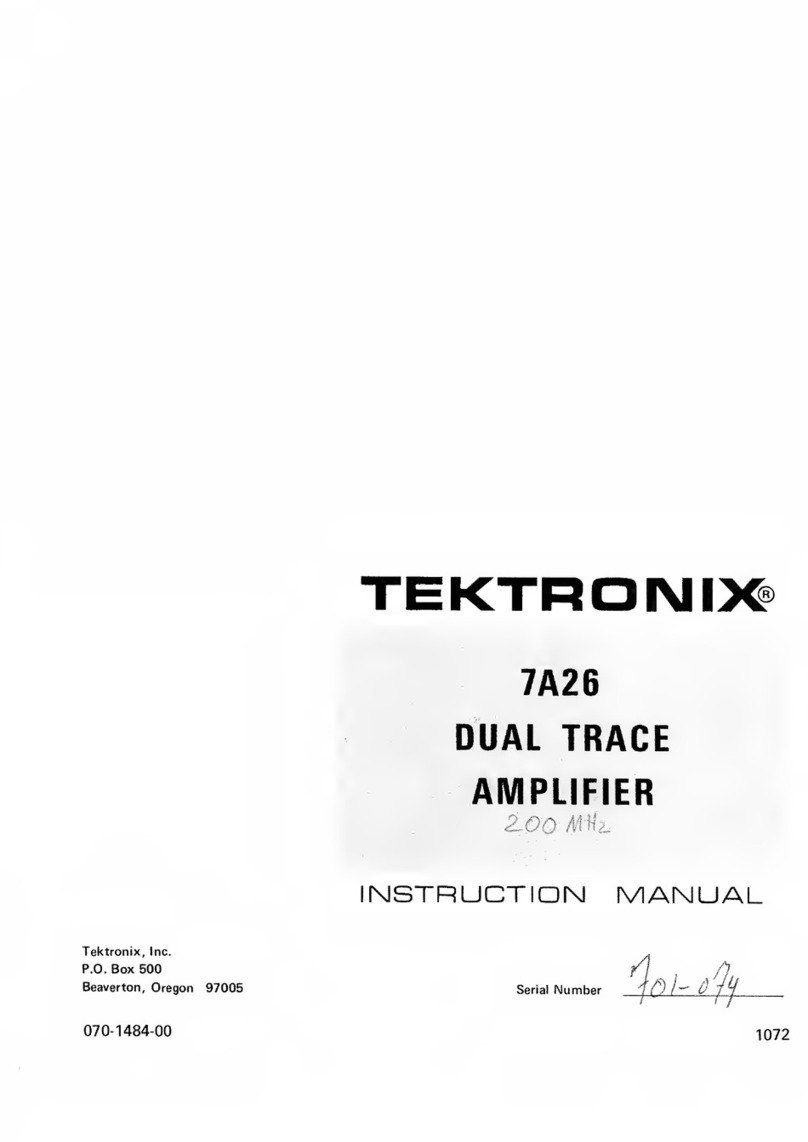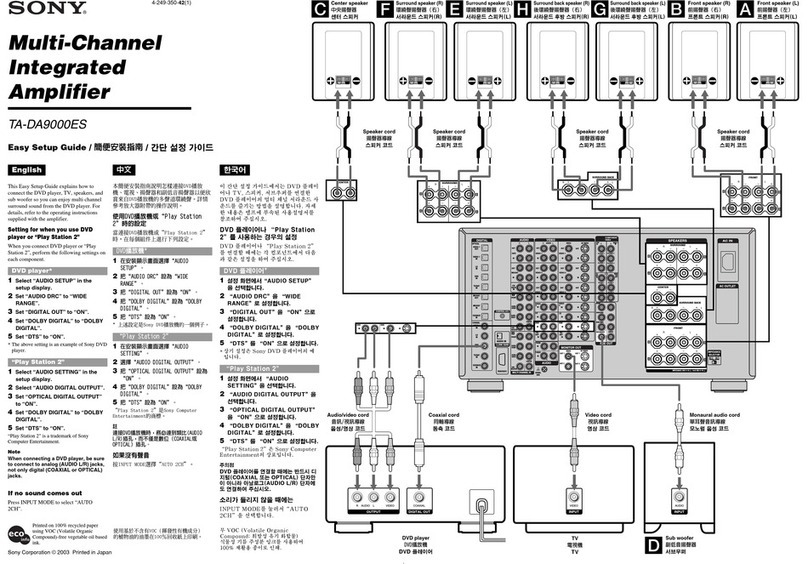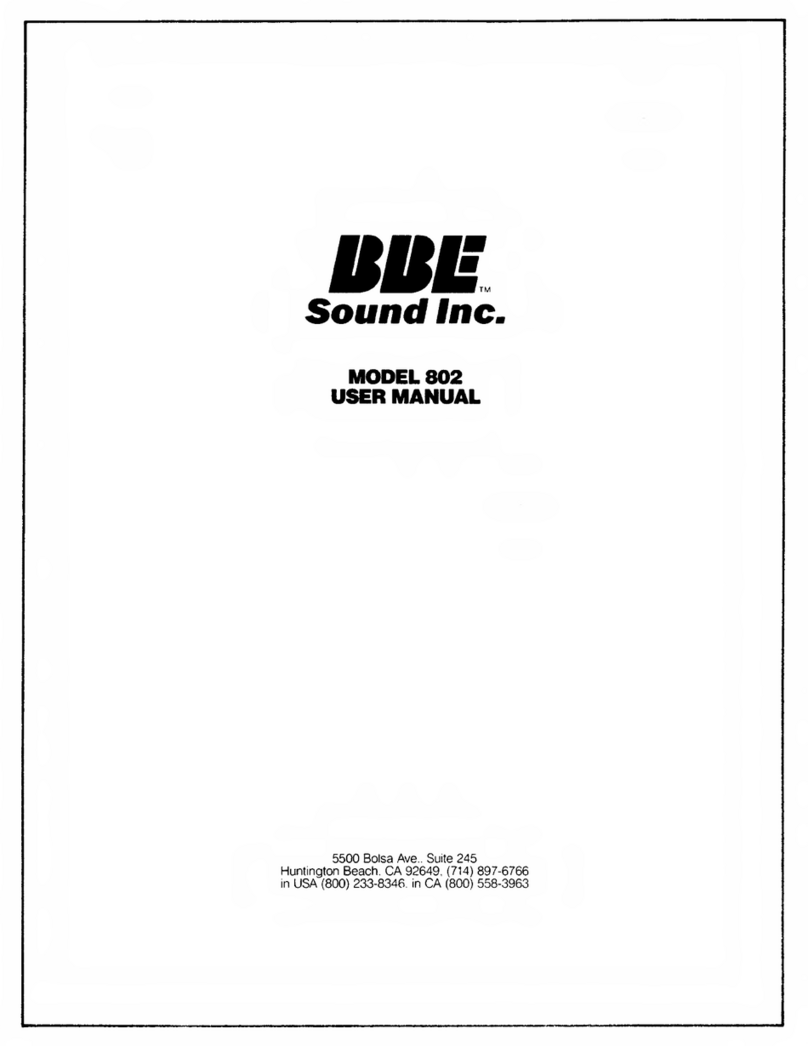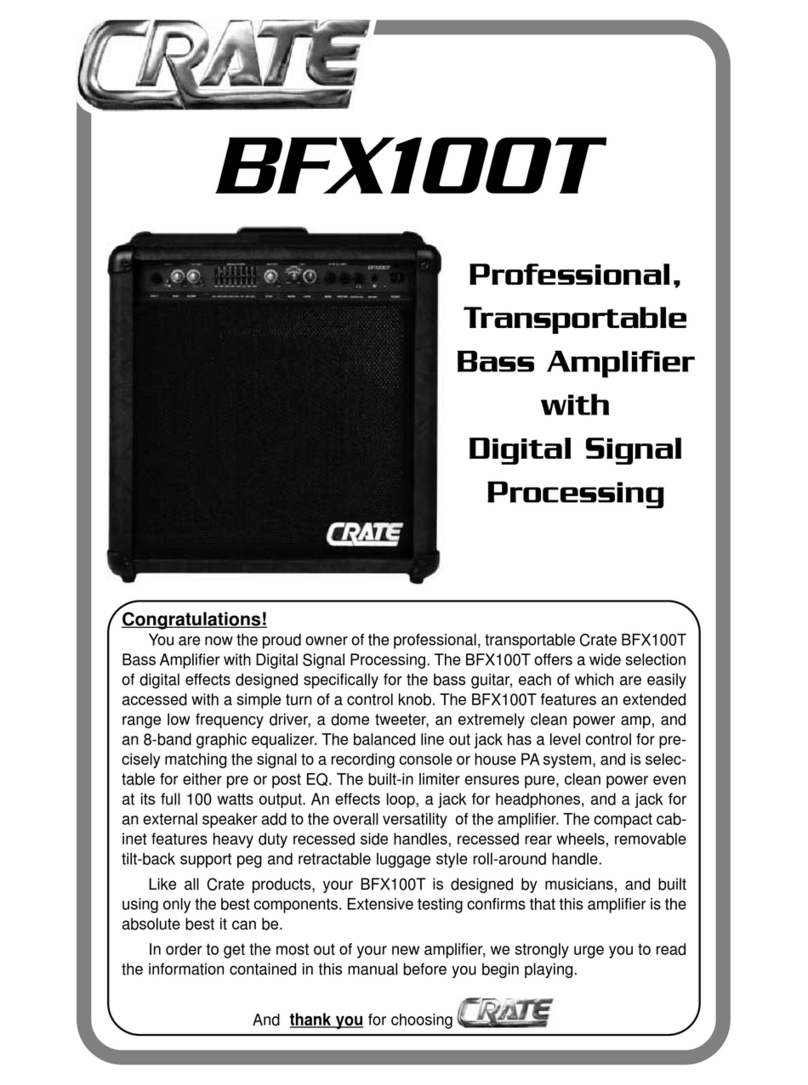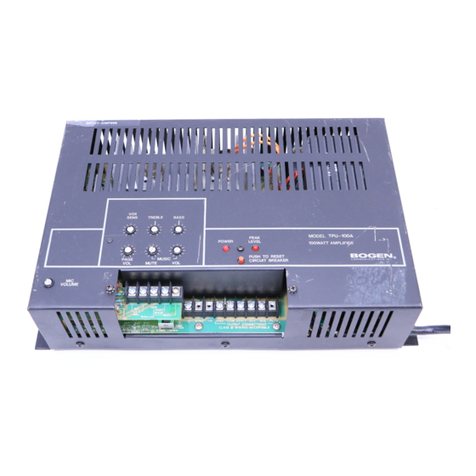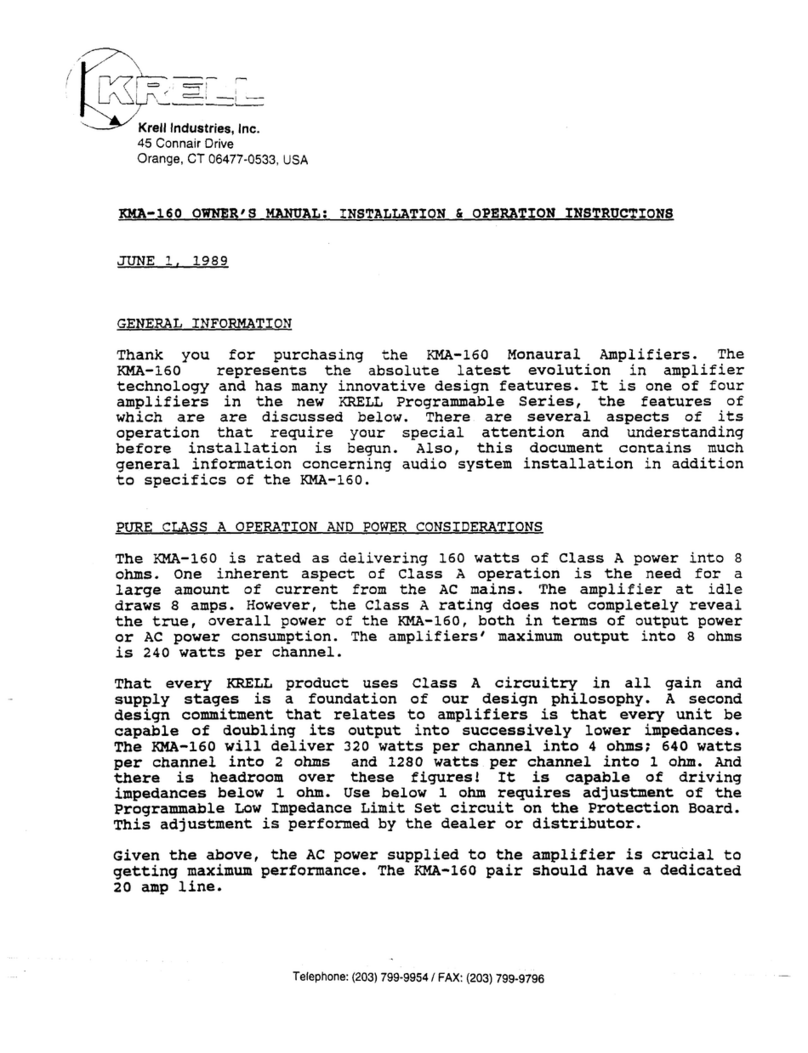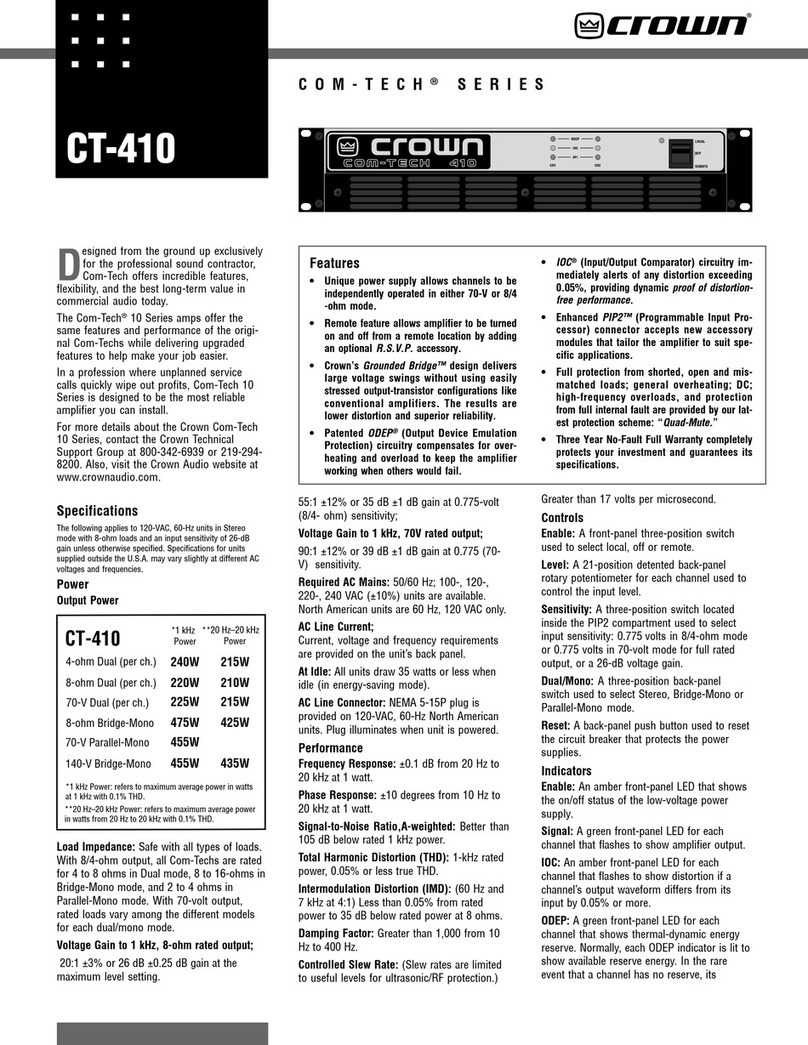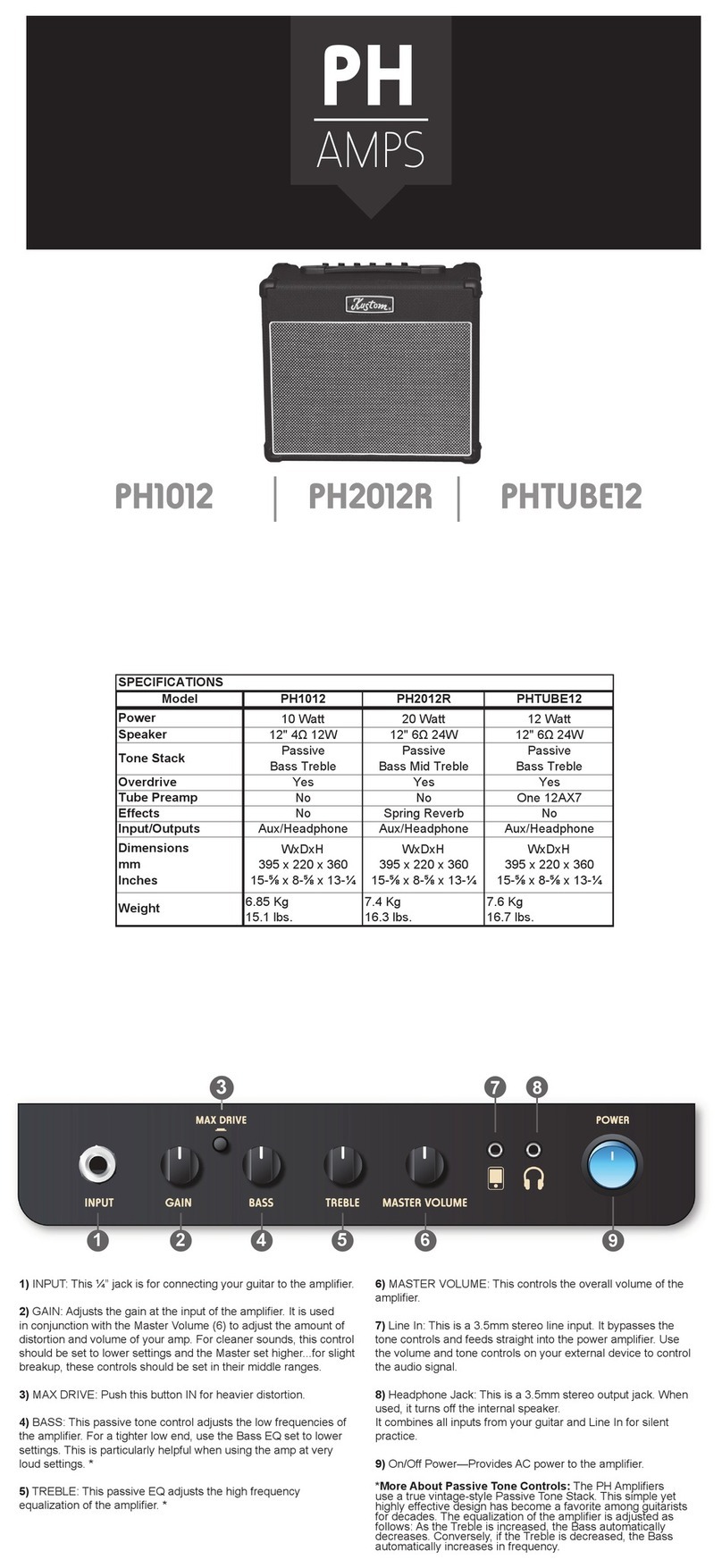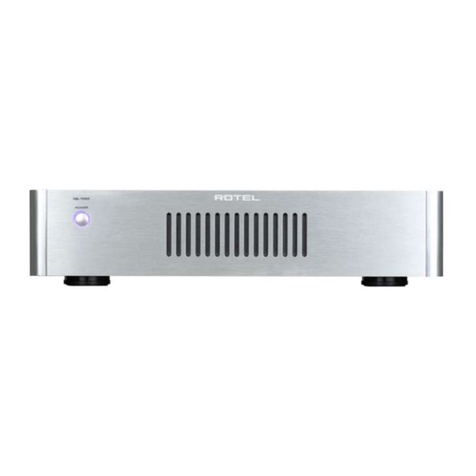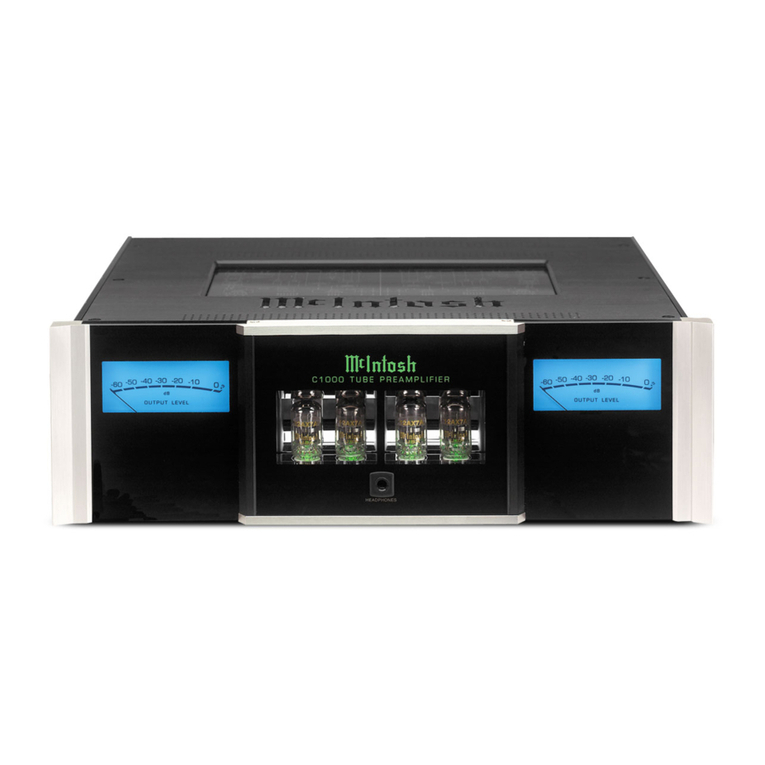Mantracourt ICA1H User manual

ICA User Manual
ICA
ICA Embedded Strain Gauge Analogue Amplifiers

Mantracourt Electronics Limited –ICA User Manual
1
Contents
Chapter 1 The ICA Range .......................................................................................................................................................2
Figure 1.1 Block Diagram ........................................................................................................................................................................................... 2
The ICA6H ......................................................................................................................................................................................................................... 2
Chapter 2 Installing the ICA Range .......................................................................................................................................3
Pre Installation ............................................................................................................................................................................................................... 3
Figure 2.1 Dimensions ................................................................................................................................................................................................. 3
ICA1H & ICA2H Connections...................................................................................................................................................................................... 4
Figure 2.2 Connection Details for the ICA1H & ICA2H .................................................................................................................................. 4
Figure 2.3 Connection Details for Best EMC Immunity for ICA1H & ICA2H .......................................................................................... 4
ICA3H & ICA6H Connections...................................................................................................................................................................................... 5
Figure 2.4 Connection Details for the ICA3H .................................................................................................................................................... 5
Figure 2.5 Connection Details for the ICA6H .................................................................................................................................................... 5
Figure 2.6 Connection Details for Best EMC Immunity for ICA3H & ICA6H .......................................................................................... 5
ICA4H Connections ........................................................................................................................................................................................................ 6
Figure 2.7 Connection Details for the ICA4H –Source mode ..................................................................................................................... 6
Figure 2.8 Connection Details for the ICA4H –Sink mode........................................................................................................................... 6
Figure 2.9 Connection Details for Best EMC Immunity for ICA4H ............................................................................................................ 6
ICA5S & ICA5A Connections....................................................................................................................................................................................... 8
Figure 2.10 Connection Details ICA5S & ICA5A ................................................................................................................................................ 8
Figure 2.11 Connection Details for Best EMC Immunity for ICA5S & ICA5A......................................................................................... 8
Output Connections...................................................................................................................................................................................................... 9
Output Shunt Resistance Formula –ICA4 and ICA5 ........................................................................................................................................ 9
Table 2.1 –The ICA H & S Cable Data ................................................................................................................................................................10
Chapter 3 Calculating Offset and Gain Resistor Values...................................................................................................11
Calculating the offset resistor values ................................................................................................................................................................11
Calculating the gain resistor values ....................................................................................................................................................................11
ICA5S & ICA5A ...............................................................................................................................................................................................................13
ICA5S & 5A Offset Resistor (Roffs)..........................................................................................................................................................................13
Offset Resistor (R1) vs Load Cell Impedance ..................................................................................................................................................14
Chapter 4 Calibration ...........................................................................................................................................................15
Figure 4.1 Connection Details for Calibration ................................................................................................................................................15
Chapter 5 Trouble Shooting.................................................................................................................................................16
Chapter 6 Product Care........................................................................................................................................................18
Chapter 7 Glossary ................................................................................................................................................................19
Chapter 8 Specifications for the ICA Range ......................................................................................................................21
Table 8.1 ICA1H (0.1 to 10.1 V) ............................................................................................................................................................................21
Figure 8.1 ICA1H Pad and Potentiometer Positions .....................................................................................................................................21
Table 8.2 ICA2H (0.1 to 5.1 V) ..............................................................................................................................................................................22
Figure 8.2 ICA2H Pad and Potentiometer Positions .....................................................................................................................................22
Table 8.3 ICA3H (±10 V) ...........................................................................................................................................................................................23
Figure 8.3 ICA3H Pad and Potentiometer Positions .....................................................................................................................................23
Table 8.4 ICA4H (4 to 20 mA) ................................................................................................................................................................................24
Figure 8.4 ICA4H Pad and Potentiometer Positions .....................................................................................................................................24
Table 8.5 ICA5S (2-wire 4-20 mA) ........................................................................................................................................................................25
Figure 8.5 ICA5S Pad and Potentiometer Positions ......................................................................................................................................25
Table 8.6 ICA5A (2-wire 4-20 mA)........................................................................................................................................................................26
Figure 8.6 ICA5A Pad and Potentiometer Positions .....................................................................................................................................26
Table 8.7 ICA6H (±10 V) ...........................................................................................................................................................................................27
Figure 8.7 ICA6H Pad and Potentiometer Positions .....................................................................................................................................27
EU DECLARATION OF CONFORMITY ....................................................................................................................................28

Mantracourt Electronics Limited –ICA User Manual
2
Chapter 1 The ICA Range
Figure 1.1 Block Diagram
The ICA is a Strain Gauge Amplifier, converting a strain gauge input to a volt or mA output –otherwise known as a
Signal Conditioner.
The ICA provides a wide range of signal conditioning for Strain Gauges, Load Cells, Pressure and Torque Transducers.
Offered in 5 Very High Stability versions:
ICA1H 3 wire - 0.1 to 10.1 V
ICA2H 3 wire - 0.1 to 5.1 V
ICA3H 4 wire -
10V /
15 V supply
ICA4H 3 wire - 4 to 20 mA
ICA6H 3 wire –
10 V / 15-24 V supply
Industrial Stability versions:
ICA5 S & A 2 wire –4 to 20mA
N.B. The ICA5 is designed for a 1000 ohm bridge or higher, however 350 ohms can be used but with reduced
performance (see Chapter 2 ‘ICA5S & ICA5A’)Transducer SENSITIVITY of between 0.5 mV/V and greater than 10 mV/V
are possible. As supplied they are optimised to 2.5 mV/V. This range covers most, but not all strain gauges.
Sensitivity adjustment (SPAN) is achieved by a combination of changing the gain (SPAN) resistor ‘R’ (see chapter 2)
and associated fine adjustment by potentiometer.
Similarly transducer ZERO can be compensated for in the module by means of the ZERO potentiometer. This
adjustment is to remove the effects of slight errors in the strain gauge. It is not intended to act as an offset tare due to
its limited range of adjustment
The ICA6H
The ICA6H is a two-part module which combines an ICA3H with a DC-DC power module.
The power module generates both positive and negative supply rails for the ICA3H thereby enabling it to produce its
normal ±10 V output from a single 15-24 V supply.
The ICA6H also has pads on its underside which can be used to mount and provide connections for a range of
Transducer Electronic Data Sheet ICs (TEDS).

Mantracourt Electronics Limited –ICA User Manual
3
Chapter 2 Installing the ICA Range
Pre Installation
See Specification details in Chapter 8 for details of Environmental Approvals.
Carefully remove the ICA unit from its shipment box. Check that the unit is complete and undamaged.
The ICA units can be operated in any industrial environment providing the following limits are not exceeded.
Operating Temperature
-40ºC to +85ºC
Humidity
95% non condensing
Storage temperature
-40ºC to +85ºC
The following installation practices are advised:
Minimise vibration
Do not mount next to strong electrical fields (transformers, power cables)
Ensure easy access to the module
Install electrical protection device as the unit is not internally fused –a short across the excitation terminals could
cause permanent damage
Always ensure the package is secure and protected
Figure 2.1 Dimensions
The module is designed to fit in the strain gauge pocket. Use the 2.1mm hole to secure the unit.
The mounting hole will accept an M2 screw or American equivalent #0-80.
Important Note: DO NOT USE #2 screw size.
Take care when soldering cables to the pads.
Use a temperature controlled soldering iron set to a maximum 330 ºC, for no longer than 2 seconds per pad. Excessive
heat or increased soldering time may result in damage to the PCB.
If changing the gain resistor ‘Rgain’ do so at a workbench and not on site.
The ICA1-6 solder pads are as shown in the following wiring diagrams:
Four pads for the strain gauge.
Power supply and output pads
Two pads for sink or source option (ICA4H only)
The fixing screw hole provides a ground connection to improve EMC performance by capacitively coupling the
electronics to the strain elements in the load cell
N.B The voltage between either of the power supply connections and the load cell chassis should not exceed 50 V. Any
leakage will be greater than 10 M ohms.

Mantracourt Electronics Limited –ICA User Manual
4
ICA1H & ICA2H Connections
The power supply for the ICA1H is nominally 24 V dc (between 13 and 28 V) and ICA2H is nominally 12 V dc (between
8.5 and 28 V).The power supply is commoned with the output at the ‘Com’ connection.
Figure 2.2 Connection Details for the ICA1H & ICA2H
The strain gauge cable should be attached to the solder pads as illustrated
For most applications 3 wire un-shielded field wiring is quite adequate.
For best EMC performance use the connections shown in Figure 2.3
Figure 2.3 Connection Details for Best EMC Immunity for ICA1H & ICA2H
Take note of the grounding arrangement particularly the bolt hole which capacitively couples the common of the ICA
electronics to the strain elements in the load cell to improve the EMC performance.

Mantracourt Electronics Limited –ICA User Manual
5
ICA3H & ICA6H Connections
The ICA3H requires a ±14 V bipolar dc power supply within the limits of ±13 V to ±15 V.
The ICA6H requires a 15 V to 24 V uni-polar dc power supply. Ideally this should be limited to between +15 V and +18
V for 350 ohm load cells to minimise the on-board temperature rise thereby reducing any warm-up time.
In both cases the power supply is commoned with the output at the ‘Com’ connection.
Figure 2.4 Connection Details for the ICA3H
The strain gauge cable should be attached to the solder pads as illustrated
For most applications 3 wire un-shielded connections for field wiring is quite adequate.
For best EMC performance use the connections shown in Figure 2.6
Figure 2.5 Connection Details for the ICA6H
The power supply connections for the ICA6H are located on the bottom PCB.
In Figure 2.6 the ‘-ve’ power supply connection can be ignored for the ICA6H.
Figure 2.6 Connection Details for Best EMC Immunity for ICA3H & ICA6H
See Figure 2.5 for ICA6H power connections.
Take note of the grounding arrangement particularly the bolt hole which capacitively couples the common of the ICA
electronics to the strain elements in the load cell to improve the EMC performance.

Mantracourt Electronics Limited –ICA User Manual
6
ICA4H Connections
The power supply for the ICA4H is 24 V dc. The ICA4H can operate over the power supply range 13 V to 28 V.
However, the minimum supply voltage is determined by the input impedance of the receiver or monitor connected to
the loop –see the ‘Output Shunt Resistance Formula’ at the end of this chapter.
Figure 2.7 Connection Details for the ICA4H –Source mode
Figure 2.8 Connection Details for the ICA4H –Sink mode
Figure 2.9 Connection Details for Best EMC Immunity for ICA4H
Take note of the grounding arrangement particularly the bolt hole which capacitively couples the common of the ICA
electronics to the strain elements in the load cell to improve the EMC performance.

Mantracourt Electronics Limited –ICA User Manual
7
The ICA4H can be used with three wire cabling in both sink and source mode. The only difference between the two
modes is whether the common end of the load is connected to the positive of the PSU (sink mode) or the negative of
the PSU (source mode).

Mantracourt Electronics Limited –ICA User Manual
8
ICA5S & ICA5A Connections
The power supply for the ICA5S should be between 7.5 and 28 V
The minimum supply for the ICA5A version is 9 V
Please note that by design, the excitation voltage provided by a 2-wire load cell amplifier decreases as the load cell's
impedance decreases resulting in a reduction in the load cell's output. The lower signal level requires more gain from
the ICA5 to compensate leading to a degradation in performance with regards to temperature stability and noise
performance.
Impedances greater than 1000 ohms and sensitivities of 1 mV/V and higher are recommended.
Figure 2.10 Connection Details ICA5S & ICA5A
The strain gauge cable should be attached to the solder pads as illustrated.
Figure 2.11 Connection Details for Best EMC Immunity for ICA5S &
ICA5A
The securing bolt should be used to provide a good electrical ground and mechanical support. This is important for
optimum EMC performance.

Mantracourt Electronics Limited –ICA User Manual
9
Output Connections
The ICA5 analogue output is 4 to 20 mA. The power and signal are combined in a single pair cable, simplifying
installation.
N.B. Neither connection to the output load is electrically common to the load cell.
Output Shunt Resistance Formula –ICA4 and ICA5
The following formula gives the suitable range of shunt resistance (including the wiring resistance) for low supply
voltage operation of the ICA4H and ICA5. Alternatively, by transposing the formula the minimum supply voltage for a
given shunt resistance can be determined.
ICA4H: the shunt resistance (input impedance of the receiver or monitor) and associated loop wiring must be less
than:
ICA5S: the shunt resistance must be less than:
ICA5A: the shunt resistance must be less than:
Example 1: ICA4H, assuming 5 ohm wiring resistance, 20 V supply
Example 2: ICA5S, assuming 10 ohm wiring resistance, 9 V supply

Mantracourt Electronics Limited –ICA User Manual
10
Table 2.1 –The ICA H & S Cable Data
This typical cable data is provided for information only.
The cable should have 2 x twin twisted cables. Ideally each pair should be individually shielded and with an overall
shield.
Country
Supplier
Part No
Description
UK
Farnell
118-2117
Individually shielded twisted multi-pair cable (7/0.25 mm)- 2 pair
Tinned copper drain. Individually shielded in polyester tape.
Diameter: 4.1 mm
Capacitance/m: core to core 115 pF & core to shield 203 pF
UK
Farnell
585-646
Individually shielded twisted multi-pair cable (7/0.25 mm)- 3 pair
Tinned copper drain. Individually shielded in polyester tape.
Diameter: 8.1 mm
Capacitance/m: core to core 98 pF & core to shield 180 pF
UK
RS
749-2591
Braided shielded twisted multi-pair cable (7/0.2 mm)- 1 pair
Miniature- twin -round Diameter: 5.2 mm
Capacitance/m: core to core 230 pF & core to shield 80 pF
If possible segregate the signal cable from Power Cables; allow a 1 metre (3 feet) distance from such cables.
Do not run signal cables in parallel with power cables and only cross such cables at right angles.
The ground connection conductor should have sufficient cross-sectional area to ensure a low impedance path to
attenuate RF interference.

Mantracourt Electronics Limited –ICA User Manual
11
Chapter 3 Calculating Offset and Gain Resistor Values
Calculating the offset resistor values
The ICA1H and 2H can be used in a pseudo ‘bipolar ±’ mode by fitting a resistor ‘Roffs’ as shown in Figure 2.2. This will
shift the output voltage to a known level (Voffs) when the input is zero (0 mV/V) allowing both tension and compression
of the load cell to be measured.
Use the following formula for the ICA1H and 2H to calculate the value of Roffs in kΩ.
The gain will also need to be changed to account for smaller changes in output resulting from a given input change.
This means that the total mV/V will change:
For the ICA1H:
For the ICA2H:
Calculating the gain resistor values
The ICA range of strain gauge amplifiers are supplied un-calibrated but optimised for a sensitivity of 2.5 mV/V. To
accommodate other sensitivities the gain resistor ‘Rgain’ shown in the connection diagrams above can be changed
according to the following formulae.
N.B. a high quality component e.g. 1 % 10-15 ppm/°C metal film resistor should be used for optimum performance. It
may be necessary to use a value from the less common E96 series to optimise the trim range.
Where:
Model
Output range
Gain constant
Resistor constant
ICA1H
0.1 to 10.1 V
372
40000
ICA2H
0.1 to 5.1 V
186
40000
ICA3H
± 10 V
372
40000
ICA4H
4 to 20 mA
160
63200
ICA6H
± 10 V
372
40000
The ICA4H has two surface mount gain resistors. These do not need to be removed if the gain is to be increased (a
lower mV/V input level). However, they need to be taken into account and an extra calculation stage is required:

Mantracourt Electronics Limited –ICA User Manual
12
If the gain is to be decreased for a higher mV/V input then the two surface mount resistors must be removed. It is then
possible to use just the top pair of formulas as with the other models.
Example 1: ICA1H, no offset, 0.5 mV/V required sensitivity.
(Use preferred value 53.6R –E96 series)
Example 2: ICA2H, no offset, 5 mV/V required sensitivity.
(Use preferred value 1k1)
Example 3: ICA3H, no offset, ±2.5 mV/V required sensitivity at ±5 V output.
(Use preferred value 549R –E96 series)
Example 4, ICA2H, 2.5 V offset, ±2.5 mV/V required sensitivity at 0.1 V and 5.1 V output.
(Use preferred value 61.9k –E96 series)
(Use preferred value 1k1)
Example 5, ICA4H, 2.0 mV/V required sensitivity
(Use preferred value 3k9 or 4k01 (E96))

Mantracourt Electronics Limited –ICA User Manual
13
ICA5S & ICA5A
The ICA5S & ICA5A (2-wire 4 - 20 mA) In-Cell strain gauge amplifiers are supplied un-calibrated but optimized for a
sensitivity of 2.5 mV/V. To accommodate other sensitivities the gain resistor ‘Rgain’ as shown in Figure 2.10, can be
changed according to the following formulas. Load cells with less than 1 mV/V sensitivity are not recommended due to
the low excitation voltage presented to the load cell by a 2-wire device (see table below).
N.B. a high quality, <=25 ppm/°C 1 % metal film resistor should be used for optimum performance. It may be
necessary to use an E96 value to optimise the trim range.
Table 3.6 ICA5S & ICA5A (4-20mA) Gain Resistor Formula
10
20000
20000
/6.613 Z
VexcVmV
Rx
k ohms
Where
VmV /
is the sensitivity of the load cell (in mV/V), Vexc is the excitation voltage (in volts) and Z is the load cell
impedance (in ohms).
e.g. For a 2.5 mV/V 1000 ohm load cell: R2 = 222.17 k ohms –use 220 k (nearest E24 preferred value) or 223k (nearest
E192 preferred value)
The following table gives calculated values of Vexc for various standard load cell impedances:
Load Cell Impedance
Excitation voltage (Vexc)
350
0.55
700
0.90
1000
1.11
1400
1.32
2000
1.54
5000
1.99
Use the following formulas to calculate the excitation voltage for cell impedances not given in the table:
6exp10762.4)/1( 1
Rcell
Rexc
ohms
1240
5.2
Rx Rx
Vexc
volts
e.g. for a 500 ohm load cell:
Rexc = 498.8 ohms
Excitation voltage, Vexc = 0.717 V
ICA5S & 5A Offset Resistor (Roffs)
The value of Roffs can be changed to offset the zero point if it is outside the normal trimming range (±2% FS).
Its value will also depend on the impedance of the load cell. The factory-fitted value, 180k is optimised for a 1000 ohm
cell.

Mantracourt Electronics Limited –ICA User Manual
14
Offset Resistor (R1) vs Load Cell Impedance
The following table gives the value of R1 for various load cell impedances and ±2% FS and 4% FS trim:
Load Cell Impedance
±2% FS
±4% FS
350 Ohms
30k
n/a
700 Ohms
100k
27k
1000 Ohms
180k
60k
5000 Ohms
1M
430k

Mantracourt Electronics Limited –ICA User Manual
15
Chapter 4 Calibration
The ICA amplifiers can be calibrated with the transducer connected provided that two calibration points can be
implemented e.g. by applying known weights or forces. If this is not possible, a stable mV source or load cell simulator
can be used if the precise sensitivity (mV/V) of the transducer is known.
Figure 4.1 Connection Details for Calibration
1. Apply the known low calibration conditions (weight, force or mV/V). This may be zero if required, and using
the ‘Z’ potentiometer (Zero), set the output to the relevant low level depending on the model e.g. 0.1 V for the
ICA1H, 4 mA for the ICA4H etc.
2. Apply the known high calibration conditions (ideally between 75% and full scale) and adjust the ‘S’
potentiometer (Span) to set the output to the relevant high level depending on the model e.g. 5.1 V for the
ICA2H at full scale, 20 mA for the ICA4H etc.
3. Re-apply the known low calibration conditions and re-adjust the Zero if required.

Mantracourt Electronics Limited –ICA User Manual
16
Chapter 5 Trouble Shooting
1. No Output
a) Check power supply is present and the correct polarity
b) Check the output connections are correct with no open circuit connections
c) Check terminations (ensure there are no dry joints)
d) Check the sensor is connected (typically reading 350 ohm across output + & -) with the power off
e) Check the Excitation voltage is at 5 V dc for the ICA1-4H & ICA6H (see Table 3.6 for ICA5S & ICA5A)
f) Check the load is connected and is not open or short circuited
g) Check Span and Gain calibration
2. Low Output
This is when an output is present but not of sufficient magnitude to meet the required value. Remember to allow for
Tare Weight and ensure it is measured and allowed for in the output from the ICA.
a) Check power supply is within specified limits (i.e. is not low)
b) Check the sensor is connected (typically reading 350 ohm across output + & -) with the power off
c) Check the Excitation voltage is at 5 V dc for the ICA1-4H & ICA6H (see Table 3.6 for ICA5S & ICA5A)
d) Check the calibration
e) Check the Zero (offset) is correct for the sensor, this too is a common reason for low outputs
3. High Output
This is when an output is present but higher (in span or zero) than expected.
High output is not normally a problem. It is most likely to be incorrect connections and as such the output would be
high and fixed
a) Check the sensor is connected (typically reading 350 ohm across output + & -) with the power off
b) Check the Excitation voltage is at 5 V dc for the ICA1-4H and 6H (see Table 3.6 for ICA5S & ICA5A)
c) Check the Zero (offset)
d) Check the calibration
4. Unstable Output
This is when the output is unstable or varies. The cause could be (a) poor installation or (b) a noisy environment.
Poor Installation -This is when an output is present but higher or lower (in span or zero) than expected:
a) Check the installation for problems and repair where necessary
b) Poor termination
c) High resistance on cable leads
d) Low insulation impedance
e) Proximity to High Voltage Equipment –Transformers, Contactors, Motors etc.
Noisy Environment -
a) Check if the source can be found and remove noise
b) Check the cable shielding and ensure it is correctly installed and terminated
5. Calibration
This section assumes that the unit is providing an output that is not stuck at top or bottom of the scale.
(See paragraphs 1-3 if this is the case)
a) Ensure you are connected to the correct sensor and not to another adjacent unit.
b) Ensure you have the correct calibration data from the sensor manufacturer. This must include a certified table
with offset, zero and linearity.
c) Ensure you have the calibration set-up correctly installed i.e. mV source and output as required.
d) Ensure the temperature and other environmental parameters are within specification and where necessary
taken into account when calibrating should such parameters have an effect on the calibration.

Mantracourt Electronics Limited –ICA User Manual
17
6. Fine Span (Gain) and Zero (Offset) Adjustment Problems
a) If the adjustment cannot reach the maximum output desired then, check the tare is not too high.
b) If the potentiometer does not alter the output the unit must be repaired –remove from service.
c) It is always wise to check a known good ICA against the problem installation before rejecting the suspect ICA.

Mantracourt Electronics Limited –ICA User Manual
18
Chapter 6 Product Care
A worn out component, excessive use in harsh environments, an overly zealous operator; regrettably some
circumstances necessitate repair.
At Mantracourt Electronics Ltd we can't guarantee that a product will never require repairing. We can, however,
promise a repair service of exceptional quality, one which is governed by a rigorous procedure.
Detailed below is our pledge to you: a defined set of ground rules and procedures to which we will adhere. All we ask
in return is that you assist us with our procedure, such that we can maintain our promise to you. Please note that
warranty repairs may not be available on overdue accounts, and that a strict interpretation of our conditions of trading
invalidates warranty claims where late payment has occurred.
Please refer to the RMA Form –(Return Material Authorization), contact your distributor for a copy.
In the unlikely event you have problems with the ICA module we would advise that you take the following
precautions:-
The unit is installed as instructed
Recommended spares are kept in stock. We can assist
Sufficient expertise available for first line maintenance
Routine maintenance checks are performed –annually is recommended
The necessary documentation for the product is available to the maintenance personnel
We recommend you keep on file –as a minimum
This Manual
The calibration figures for the attached sensors
A record of the ‘normal’ output – if applicable
A calibration record of the ICA
A contact phone number from the supplier for assistance

Mantracourt Electronics Limited –ICA User Manual
19
Chapter 7 Glossary
AWG
American Wire Gauge
Background Noise
The total noise floor from all sources of interference in a measurement system,
independent of the presence of a data signal. (See Noise)
Bipolar
The ability of a signal conditioner to display both positive and negative readings
Bridge Resistance
The resistance measured across the excitation terminals of a Strain Gauge.
Calibration
Adjustment of an instrument or compiling a deviation chart so that its reading
can be correlated to the actual value being measured
CMR
(Common-Mode
Rejection)
The ability of an instrument to eliminate the effect of AC or DC noise between
signal and ground. Normally expressed in dB at DC to 60 Hz. One type of CMR is
specified between SIG LO and PWR GND. In differential meters, a second type of
CMR is specified between SIG LO and ANA GND (METER GND)
Common Mode
Rejection Ratio
The ability of an instrument to reject interference from a common voltage at its
input terminals with relation to ground. Usually expressed in dB (decibels).
Drift
Change of a reading/set point value over periods due to several factors including
change in ambient temperature, time and line voltage
Excitation
The external application of electrical voltage current applied to a transducer for
normal operation
Fine Adjustment
Zero and Span calibration have a Fine Adjustment to give accuracy to the
calibration. These are potentiometers Sand Zfor Span and Zero respectively
Full Bridge
A Wheatstone Bridge configuration utilizing four active elements or Strain
Gauges
Full Range Output
The algebraic difference between the minimum output and maximum output.
Gain
Gain is otherwise identified as SPAN. It relates to the proportional output to the
sensor input. Calibration of the ICA is determined by setting the Gain (Span) and
Offset (Zero). The amount of amplification used in an electrical circuit
Ground
The electrical neutral line having the same potential as the surrounding ground
Linearity
The closeness of a calibration curve to a specified straight line. Linearity is
expressed as the maximum deviation of any calibration point on a specified
straight line during any one calibration cycle
Load
The electrical demand of a process expressed as power (watts), current (amps) or
resistance (ohms)
Load Impedance
The impedance presented to the output terminals of a transducer by the
associated external circuitry
Load Cell
The load cell is one of a series of STRAIN GAUGE sensors that the ICA input is
designed to accept. (Torque Sensor, Pressure & temperature transducers)
Millivolt
One thousandth of a volt, 10-3 volts symbol mV
Noise
An unwanted electrical interference on the signal wires
Null
A condition, such as balance, which results in a minimum absolute value of
output
Offset
Offset is otherwise identified as ZERO. Calibration of the ICA is determined by
setting the Offset (Zero) and Gain (Span)
Potentiometer
Two potentiometers (variable resistors) are used for fine calibration
Pressure
Transducer
The Pressure Transducer is one of a series of Strain Gauge sensors that the ICA
input is designed to accept. (Torque Sensor, Load Cell and Temperature
Transducers)
Proportional
Outputs
The Voltage or Current outputs are calibrated to be directly proportional to the
input from the sensor. The output is, within the sensor limits, taken as linear and
no linearity compensation is required within the ICA
Resolution
The input corresponding to a one-unit change in the least significant digit of the
data acquisition/display equipment (Good resolution is not necessarily equal to
good accuracy.)
This manual suits for next models
4
Table of contents
Other Mantracourt Amplifier manuals
